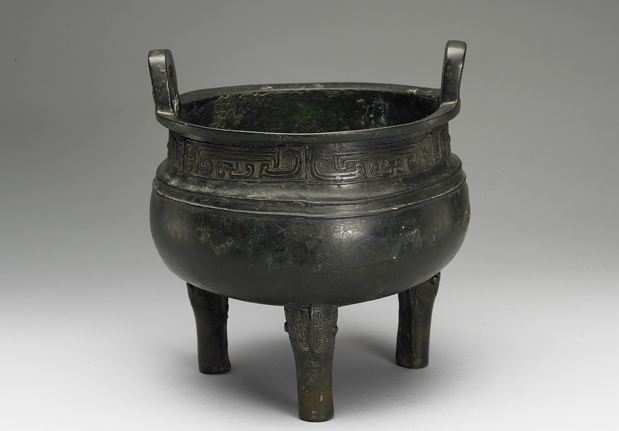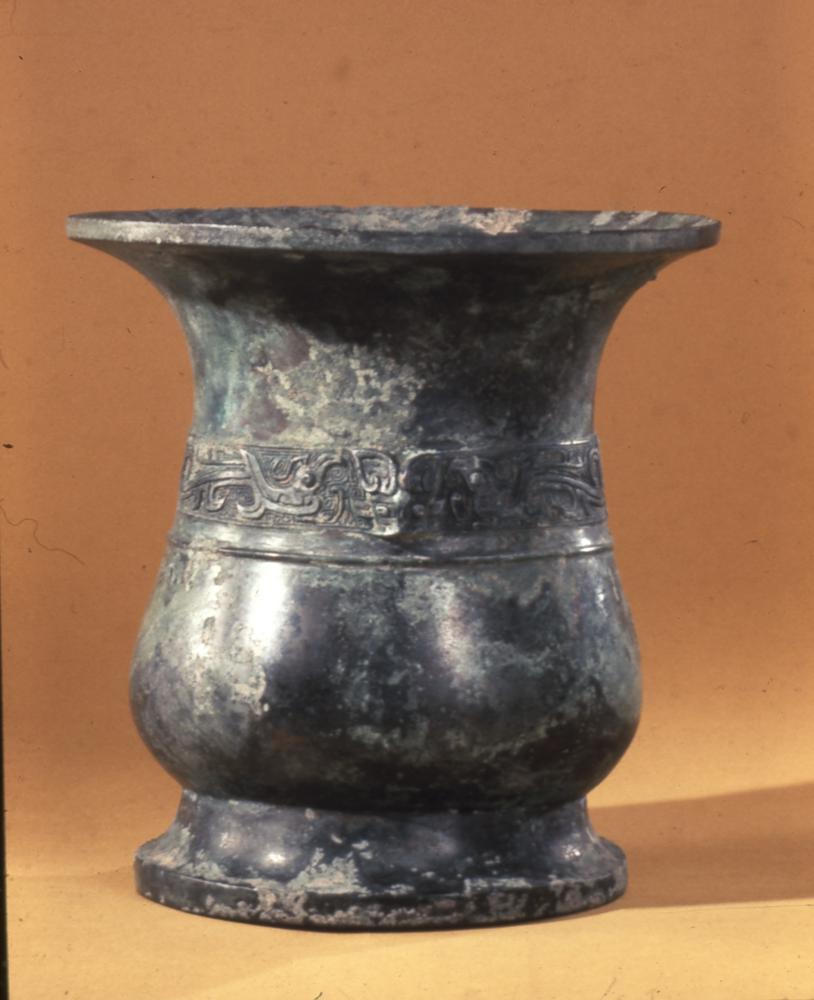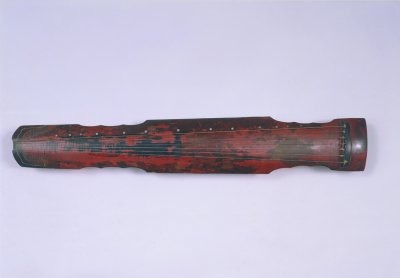Period:Unknown Production date:1stC-4thC (Whitfield 1985)
Materials:fired clay, 陶器 (Chinese),
Technique:mould-made, incised, 模製 (Chinese), 雕刻 (Chinese),
Dimensions:Height: 4.60 centimetres Width: 4.60 centimetres
Description:
Round clay plaque depicting a face with a broad nose and bulging eyes, cheeks and forehead. The plaque is fragmentary and only a small part of the hair and the beard can still be seen. Considering the evil facial expression, this is probably a representation of a demon. The plaque was most likely used as an appliqué for a vessel. For an almost identical object see MAS.105
IMG
![图片[1]-plaque; 飾板(Chinese) BM-MAS.66-China Archive](https://chinaarchive.net/Unknown/43/mid_01148011_001.jpg)
![图片[2]-plaque; 飾板(Chinese) BM-MAS.66-China Archive](https://chinaarchive.net/Unknown/43/mid_00008844_003.jpg)
Comments:EnglishFrom Whitfield 1985:Plate 78-1 illustrates further variants of the grotesque masks and faces applied to the large Yotkan vases, using the same means of moulding, stamping and incising, and simplification and exaggeration for maximum effect.The heads of human figures, both male (Pl. 78-2) and female (Pl. 78-3), like-wise make use of moulding with additional appliqué and tooling to give a wide variety of appearance and expression. Such differences can be seen in the three female heads: the eyes of the one on the left are in appliqué, with punched holes for pupils, and corners of the mouth, giving a mask-like appearance: those of the one on the right are similar, but with a ring punch for the pupils, while the incised eyes of the middle piece give it a more naturalistic appearance. All three have prominent topknots, the central one bound by a jeweled circlet. As Stein observed (Serindia, Vol. I, p. 107), there is great variety in the dressing of the back hair, and some of the typical arrangements can be seen in the side views of other heads. That on the left in Fig. 104 and those in Fig. 105 have the same pointed fringe as the heads in the colour plate; the topknot of the left-hand head in Fig. 104 has a short pigtail hanging from it and a second main pigtail from the back of the head is looped up to join it. The other head in this figure has an even more elaborate form with a frame and cushion supporting the hair, and side curls on the cheeks. In Fig. 105 the head on the right is more delicately modelled and incised: the hair on the top of the head is flattened, with a short tail meeting the main plait rising from the back.These heads are all very small and of necessity used only the simplest means of depiction, yet the more delicate examples among them are sufficient to enable us to glimpse a sophisticated and elegant society in the Khotan area in the early centuries A.D. ChineseFrom Whitfield 1985:圖78-1中,進一步展示的約特幹的大壺上貼的面具的千變萬化。其製作方法是先用模子翻製,然後用模壓或刻劃,以最簡單的方式産生最大的誇張效果。男性(圖78-2)和女性(圖78-3)的人物面具仍然是使用模子製作,通過各種工具及手段使相貌和表情産生各種不同的變化。這種變化特別在三個女性頭上最爲顯著:左邊像的眼睛是粘貼的,瞳孔和鼻孔上也有洞,嘴角多少顯出面具的特徵。右端像的情況也一樣,只是瞳孔是用環狀物壓的,而中間像的眼睛則是用刻劃的,表現更爲自然。三個頭上都有突出的髮髻,中間像用珠飾束紮髮髻。正如斯坦因的觀察(《西域》,第1卷,107頁),後面的髮型极富變化,這種典型的例子,还可见许多其它頭部的側面圖。Fig. 104左側的像和本圖都同樣有尖角的劉海,但結髮髻的髮端短短的垂下,下面的髮往上结出大的環。右側像的髮型,支着髮髻框、墊著髮墊,有几分華麗,臉頰上有卷毛。Fig. 105右側的頭部,模型和刻劃都很精巧:髮髻在頂部結成平的,短垂的髮端在後邊編結。這些頭像都極小,當然只能進行最為簡單的刻劃。儘管如此,從這些精巧的作品之中足以使我們感覺到了昔日和田地區富有經驗而優雅的社會風貌。
Materials:fired clay, 陶器 (Chinese),
Technique:mould-made, incised, 模製 (Chinese), 雕刻 (Chinese),
Dimensions:Height: 4.60 centimetres Width: 4.60 centimetres
Description:
Round clay plaque depicting a face with a broad nose and bulging eyes, cheeks and forehead. The plaque is fragmentary and only a small part of the hair and the beard can still be seen. Considering the evil facial expression, this is probably a representation of a demon. The plaque was most likely used as an appliqué for a vessel. For an almost identical object see MAS.105
IMG
![图片[1]-plaque; 飾板(Chinese) BM-MAS.66-China Archive](https://chinaarchive.net/Unknown/43/mid_01148011_001.jpg)
![图片[2]-plaque; 飾板(Chinese) BM-MAS.66-China Archive](https://chinaarchive.net/Unknown/43/mid_00008844_003.jpg)
Comments:EnglishFrom Whitfield 1985:Plate 78-1 illustrates further variants of the grotesque masks and faces applied to the large Yotkan vases, using the same means of moulding, stamping and incising, and simplification and exaggeration for maximum effect.The heads of human figures, both male (Pl. 78-2) and female (Pl. 78-3), like-wise make use of moulding with additional appliqué and tooling to give a wide variety of appearance and expression. Such differences can be seen in the three female heads: the eyes of the one on the left are in appliqué, with punched holes for pupils, and corners of the mouth, giving a mask-like appearance: those of the one on the right are similar, but with a ring punch for the pupils, while the incised eyes of the middle piece give it a more naturalistic appearance. All three have prominent topknots, the central one bound by a jeweled circlet. As Stein observed (Serindia, Vol. I, p. 107), there is great variety in the dressing of the back hair, and some of the typical arrangements can be seen in the side views of other heads. That on the left in Fig. 104 and those in Fig. 105 have the same pointed fringe as the heads in the colour plate; the topknot of the left-hand head in Fig. 104 has a short pigtail hanging from it and a second main pigtail from the back of the head is looped up to join it. The other head in this figure has an even more elaborate form with a frame and cushion supporting the hair, and side curls on the cheeks. In Fig. 105 the head on the right is more delicately modelled and incised: the hair on the top of the head is flattened, with a short tail meeting the main plait rising from the back.These heads are all very small and of necessity used only the simplest means of depiction, yet the more delicate examples among them are sufficient to enable us to glimpse a sophisticated and elegant society in the Khotan area in the early centuries A.D. ChineseFrom Whitfield 1985:圖78-1中,進一步展示的約特幹的大壺上貼的面具的千變萬化。其製作方法是先用模子翻製,然後用模壓或刻劃,以最簡單的方式産生最大的誇張效果。男性(圖78-2)和女性(圖78-3)的人物面具仍然是使用模子製作,通過各種工具及手段使相貌和表情産生各種不同的變化。這種變化特別在三個女性頭上最爲顯著:左邊像的眼睛是粘貼的,瞳孔和鼻孔上也有洞,嘴角多少顯出面具的特徵。右端像的情況也一樣,只是瞳孔是用環狀物壓的,而中間像的眼睛則是用刻劃的,表現更爲自然。三個頭上都有突出的髮髻,中間像用珠飾束紮髮髻。正如斯坦因的觀察(《西域》,第1卷,107頁),後面的髮型极富變化,這種典型的例子,还可见许多其它頭部的側面圖。Fig. 104左側的像和本圖都同樣有尖角的劉海,但結髮髻的髮端短短的垂下,下面的髮往上结出大的環。右側像的髮型,支着髮髻框、墊著髮墊,有几分華麗,臉頰上有卷毛。Fig. 105右側的頭部,模型和刻劃都很精巧:髮髻在頂部結成平的,短垂的髮端在後邊編結。這些頭像都極小,當然只能進行最為簡單的刻劃。儘管如此,從這些精巧的作品之中足以使我們感覺到了昔日和田地區富有經驗而優雅的社會風貌。
© Copyright
The copyright of the article belongs to the author, please keep the original link for reprinting.
THE END





